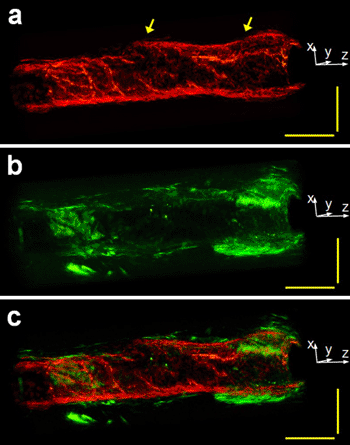Hybrid Medical Imaging Technology May Provide New Window into Cancer Mechanisms
By MedImaging International staff writers
Posted on 23 Aug 2012
Scientists have developed a new type of medical imaging that gives medical professionals with a new view of live internal organs.Posted on 23 Aug 2012
The imaging integrates two existing forms of medical imaging--photoacoustic and ultrasound-- and employs them to generate a combined high contrast, high-resolution image that could help clinicians locate tumors more rapidly, according to the investigators, from the University of Southern California (USC; Los Angeles, USA) and Washington University in St. Louis (MO, USA). “Photoacoustic endoscopy provides deeper penetration than optical endoscopy and more functional contrast than ultrasonic endoscopy,” said Lihong Wang, PhD, lead investigator and corresponding author of a study on the new technology that appeared in Nature Medicine on July 15, 2012, and professor in the department of biomedical engineering in engineering & applied science at Washington University in St. Louis.

Image: The image at the bottom is a composite of the first two taken of a rabbit esophagus in vivo (Photo courtesy of Qifa Zhou).
Dr. Wang collaborated with Drs. Qifa Zhou, Ruimin Chen, and K. Kirk Shung of USC as well as Joon-Mo Yang, Christopher Favazza, Junjie Yao, Xin Cai, and Konstantin Maslov from Washington University. “This is a first time that we have had small endoscopy with two imaging modalities,” said Dr. Qifa Zhou, one of the lead investigators and coauthors of the study, and a professor at the US National Institutes of Health (NIH) Resource Center for Medical Ultrasonic Transducer Technology at USC Biomedical Engineering.
Currently, physicians regularly employ ultrasound endoscopy to examine internal organs. This technology positions an ultrasound camera, similar to ones used to create images of fetuses, on a flexible scope that can be inserted internally. Although these images are typically high-resolution, they are also low-contrast--generating a dim image, similar to a photograph taken in a dimly lit room. To tackle this obstacle, the scientists added a photoacoustic-imaging device to the ultrasound endoscope. The resulting camera hits organ tissue with a light. When the light is absorbed by tissue, the tissue gets slightly hotter and expands. That expansion produces a sound pressure wave that the ultrasound device on the endoscope picks up. “This technology combines the best of both worlds,” said Dr. Kirk Shung, director of the NIH Resource Center and a professor of biomedical engineering at USC.
The researchers have evaluated their new device inside the gastrointestinal tract, generating in vivo images detailed enough to show blood vessels as well as the density of the neighboring tissue. “This imaging has fine resolution and high contrast,” said Joon-Mo Yang, PhD, a postdoctoral researcher in Dr. Wang’s group. With a more precise image of what is happening inside the gastrointestinal tract, physicians could potentially target colon and prostate cancers earlier.
Related Links:
University of Southern California
Washington University in St. Louis






 Guided Devices.jpg)







